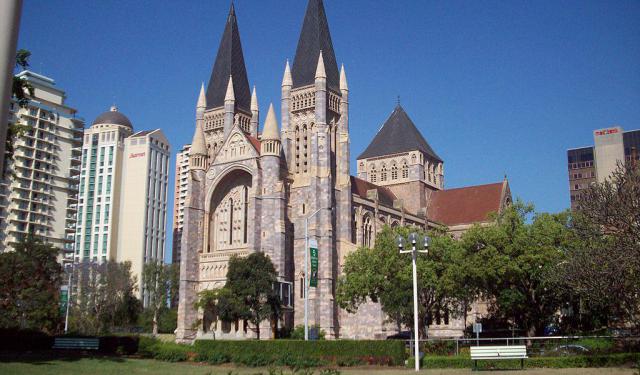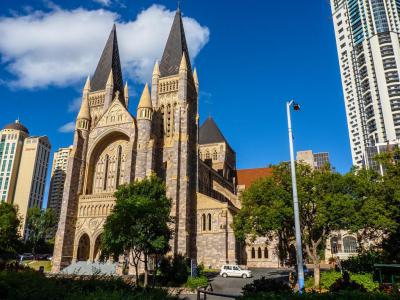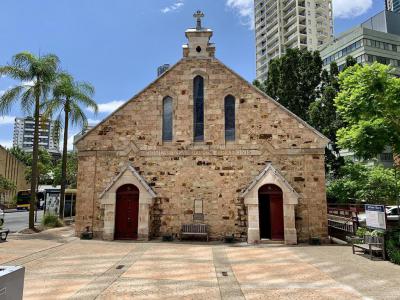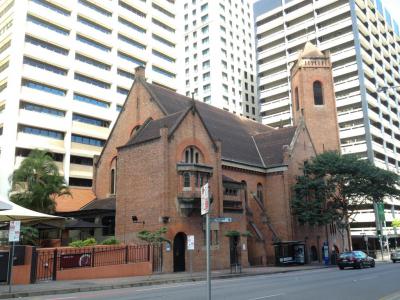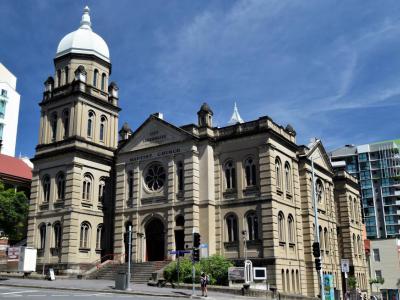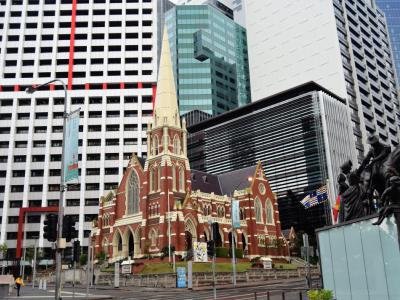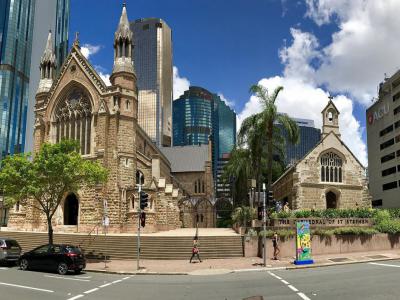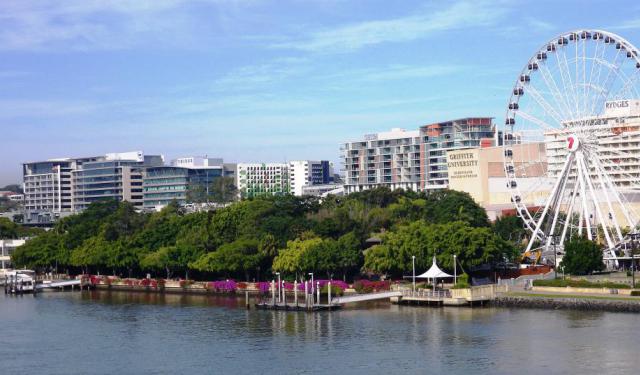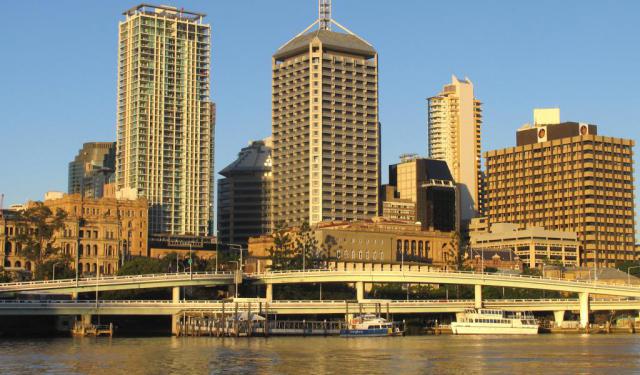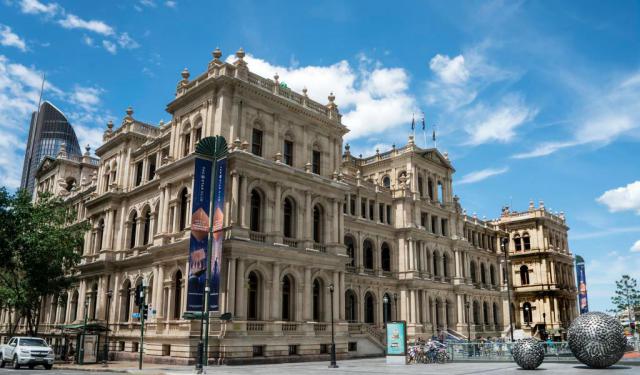Historical Churches Tour (Self Guided), Brisbane
Brisbane has no shortage of religious sites among other things. Renowned for their beauty and cultural value, the historical churches of Brisbane hold a significant place in the city's architectural heritage and attract a huge number of visitors. Let's take a closer look at some of these notable temples.
Our first point of interest is Saint John's Cathedral, an iconic Anglican church in the heart of the city. Its stunning Gothic Revival architecture, featuring intricate stained glass windows and towering rooftops, makes it a must-visit for history and architecture enthusiasts.
A short walk from there to Wickham Terrace, home to All Saints Church, reveals a historic Anglican church with a heritage-listed sandstone exterior. The church's serene atmosphere and timeless design make it a peaceful retreat from the bustling city.
Heading further down Ann Street, we eventually arrive at Saint Andrews Church, another Anglican parish located in the inner-city suburb of South Brisbane. Its beautiful stone exterior is complemented by a warm, welcoming interior enhanced with a grand pipe organ.
Our next stop is the City Tabernacle Baptist Church. A beacon of faith and community for over a century, it boasts striking architectural features and an inclusive congregation, collectively making it a unique spiritual experience.
The Albert Street Uniting Church is a notable example of Victorian Gothic architecture. Nestled amidst modern skyscrapers, this church offers a serene escape and a glimpse into Brisbane's past.
Finally, the Cathedral of Saint Stephen, the principal Catholic church in Brisbane, showcases an impressive Neo-Gothic style. With its towering silhouette and ornate interiors, it's a testament to the city's rich religious history.
More than just places of worship, the sacred places of Brisbane are living testaments to the city's enduring faith and commitment to preserving its heritage. So, why not take a step back in time and explore their architectural beauty firsthand? Our self-guided tour is a chance to let their timeless charm and spirituality inspire you!
Our first point of interest is Saint John's Cathedral, an iconic Anglican church in the heart of the city. Its stunning Gothic Revival architecture, featuring intricate stained glass windows and towering rooftops, makes it a must-visit for history and architecture enthusiasts.
A short walk from there to Wickham Terrace, home to All Saints Church, reveals a historic Anglican church with a heritage-listed sandstone exterior. The church's serene atmosphere and timeless design make it a peaceful retreat from the bustling city.
Heading further down Ann Street, we eventually arrive at Saint Andrews Church, another Anglican parish located in the inner-city suburb of South Brisbane. Its beautiful stone exterior is complemented by a warm, welcoming interior enhanced with a grand pipe organ.
Our next stop is the City Tabernacle Baptist Church. A beacon of faith and community for over a century, it boasts striking architectural features and an inclusive congregation, collectively making it a unique spiritual experience.
The Albert Street Uniting Church is a notable example of Victorian Gothic architecture. Nestled amidst modern skyscrapers, this church offers a serene escape and a glimpse into Brisbane's past.
Finally, the Cathedral of Saint Stephen, the principal Catholic church in Brisbane, showcases an impressive Neo-Gothic style. With its towering silhouette and ornate interiors, it's a testament to the city's rich religious history.
More than just places of worship, the sacred places of Brisbane are living testaments to the city's enduring faith and commitment to preserving its heritage. So, why not take a step back in time and explore their architectural beauty firsthand? Our self-guided tour is a chance to let their timeless charm and spirituality inspire you!
How it works: Download the app "GPSmyCity: Walks in 1K+ Cities" from Apple App Store or Google Play Store to your mobile phone or tablet. The app turns your mobile device into a personal tour guide and its built-in GPS navigation functions guide you from one tour stop to next. The app works offline, so no data plan is needed when traveling abroad.
Historical Churches Tour Map
Guide Name: Historical Churches Tour
Guide Location: Australia » Brisbane (See other walking tours in Brisbane)
Guide Type: Self-guided Walking Tour (Sightseeing)
# of Attractions: 6
Tour Duration: 1 Hour(s)
Travel Distance: 1.8 Km or 1.1 Miles
Author: gene
Sight(s) Featured in This Guide:
Guide Location: Australia » Brisbane (See other walking tours in Brisbane)
Guide Type: Self-guided Walking Tour (Sightseeing)
# of Attractions: 6
Tour Duration: 1 Hour(s)
Travel Distance: 1.8 Km or 1.1 Miles
Author: gene
Sight(s) Featured in This Guide:
- St. John's Cathedral
- All Saints Church
- St. Andrews Church
- City Tabernacle Baptist Church
- Albert Street Uniting Church
- Cathedral of St. Stephen
1) St. John's Cathedral
Saint John’s Cathedral is one of the most impressive churches in Brisbane and is used for important Anglican occasions such as the ordination of priests or deacons. In addition, it is an important part of the Brisbane arts scene with its own orchestra that holds many events and concerts throughout the year. It is also home to the largest cathedral pipe organ in Australia and has an acclaimed choir. In the tradition of grand medieval cathedrals in Europe, Saint John’s is the only Australian cathedral that has been completed over more than a century with stonemasons, architects and the diocese working together.
The work has resulted in a stunning Gothic revival cathedral designed by one of England’s most prestigious 19th century architects, John Loughborough Pearson. This was to be his final masterpiece and he died just prior to the final plans being approved. The project was taken over by his son Frank. The most recent additions to the cathedral have been the western spires clad in copper, which were hoisted into place in 2008. One of the highlights of the interior of the cathedral are the mosaics brought back from the “Holy Land” by WWI Australian light horsemen: you can see them in front of the cathedral altar.
The work has resulted in a stunning Gothic revival cathedral designed by one of England’s most prestigious 19th century architects, John Loughborough Pearson. This was to be his final masterpiece and he died just prior to the final plans being approved. The project was taken over by his son Frank. The most recent additions to the cathedral have been the western spires clad in copper, which were hoisted into place in 2008. One of the highlights of the interior of the cathedral are the mosaics brought back from the “Holy Land” by WWI Australian light horsemen: you can see them in front of the cathedral altar.
2) All Saints Church
Founded in 1862, All Saints Church is the oldest Anglican church in Brisbane and the construction that you see today dates from 1869. It is located on Wickham Terrace, which is one of the most historical streets in the city. The land was acquired to be a sister congregation for Saint John’s Church of England and construction was led by the Bishop Tufnell, who also selected the church’s name. It was designed in the Gothic Revival style and features sandstone buttressed walls. From its very beginnings the church enjoyed a large and enthusiastic congregation and it is often known as “the Parish Church of the City of Brisbane.”
During its long history it has had high profile parishioners including two state premiers – Sir James Dickson and Sir Robert Ramsey McKenzie. The stained glass windows are the oldest in Queensland and there are significant sculptured art by well known Depression era sculptor Daphne Mayo. The church is now a heritage listed building in recognition of the important role it played in colonial Queensland. There are many scheduled services throughout the week and the church is open to visitors at other times. It is sometimes possible to find a person who can provide an informal tour of the interior and grounds of the church.
During its long history it has had high profile parishioners including two state premiers – Sir James Dickson and Sir Robert Ramsey McKenzie. The stained glass windows are the oldest in Queensland and there are significant sculptured art by well known Depression era sculptor Daphne Mayo. The church is now a heritage listed building in recognition of the important role it played in colonial Queensland. There are many scheduled services throughout the week and the church is open to visitors at other times. It is sometimes possible to find a person who can provide an informal tour of the interior and grounds of the church.
3) St. Andrews Church
Saint Andrews Church is one of Brisbane’s grandest churches, built in Romanesque style; it is well known for its grand pipe organ. The church was built in 1905 as Presbyterian, but became a Uniting Church when the non-conformist denominations merged in 1977. Originally the congregation met on Wickham Terrace, but when their space was needed for railways a competition was held for the design of the proposed church on the corner of Ann and Creek Streets. It was won by George Payne who presented plans for a Neo-Romanesque style and bagged the 100 pounds reward. Although it was originally viewed with some trepidation by Brisbane residents who were expecting a grand Gothic design, it is now heavily regarded as the finest example of Neo-Romanesque in the Southern Hemisphere.
In the 1920s the Saint Andrews underwent extensive renovations with a more ornate entrance from Ann Street into the sanctuary and from Creek Street into the Hall added. In this same period the stunning stained glass windows of the church were finally completed. The church was most recently refurbished in 1999. One of the main features of the façade is the bell tower, which is still used to call the congregation to church on Sundays.
In the 1920s the Saint Andrews underwent extensive renovations with a more ornate entrance from Ann Street into the sanctuary and from Creek Street into the Hall added. In this same period the stunning stained glass windows of the church were finally completed. The church was most recently refurbished in 1999. One of the main features of the façade is the bell tower, which is still used to call the congregation to church on Sundays.
4) City Tabernacle Baptist Church
The City Tabernacle Baptist Church was the first Baptist church in the state. The congregation first began to meet in 1859 at a site on Wharf Street, but by 1890 the grand church that you see today had been commissioned and built. The grand church was done in the Romanesque and Venetian styles and features a lovely rose window at the façade. At the southwestern corner of the entrance to the church is a three story bell tower and cupola. It was designed by the well known Brisbane architect Richard Gailey and is one of the finest examples of his designs. Gailey was himself a member of the 400 strong congregation when the building of the church was put forward. His design therefore was a true labor of love and piety. He also designed the surviving church manse, which is located adjacent to the church.
The Whitehouse pipe organ was installed in 1915 and has recently undergone renovation. At the turn of the century Miss Fewings Private School for Girls was located in the church basement and this later became one of Queensland’s best regarded private schools – Somerville House. The building is now heritage listed by the state government.
The Whitehouse pipe organ was installed in 1915 and has recently undergone renovation. At the turn of the century Miss Fewings Private School for Girls was located in the church basement and this later became one of Queensland’s best regarded private schools – Somerville House. The building is now heritage listed by the state government.
5) Albert Street Uniting Church
The Albert Street Uniting Church began construction in 1889 and is an excellent example of the Victorian Gothic Revival style that was so popular in the colony at the time. The first Methodist congregation of Brisbane began in 1849 and met at an Albert Street address, but as the church grew it became clear that a larger space was required. A competition to choose the design was established and G H M Addison won for his plans. On August 18, 1888 five foundation stones were laid down by high profile parishioners and the church was completed in 1889. It features a cruciform shape, with a steeply pitched roof and buttressing and a high bell tower and spire.
In the tradition of the Methodist Church there was a heavy emphasis on music and a grand organ was installed. The organ came from England and was enveloped in gold leaf. The design means that the organ and the pulpit are the direct focus of the seated congregation. The church is open Monday to Friday to visitors from 10am to 2pm and you can arrange for tours of the church in advance – it is free, but a small donation is appreciated.
In the tradition of the Methodist Church there was a heavy emphasis on music and a grand organ was installed. The organ came from England and was enveloped in gold leaf. The design means that the organ and the pulpit are the direct focus of the seated congregation. The church is open Monday to Friday to visitors from 10am to 2pm and you can arrange for tours of the church in advance – it is free, but a small donation is appreciated.
6) Cathedral of St. Stephen
When Queensland separated from New South Wales in 1859 it was deemed that Brisbane should have its very own grand cathedral. The Catholic diocese set to work and a Gothic Revival cruciform design was approved.
Groundbreaking of the Cathedral of Saint Stephen began in 1863. Building of the church was slow and had many issues along the way. The first architect, Benjamin Backhouse, planned a grand cathedral. Those plans were stopped once the foundation was put down and Backhouse was replaced. There were issues with funding.
Richard George Suter was the next architect. He designed the Gothic Revival-style structure that still exists today. He was also eventually replaced by the Hennessy & Hennessy architectural firm. Building of the cathedral would not be completed until 1989.
There are a number of buildings on the cathedral grounds that visitors may find interesting to explore. Saint Stephen's Chapel, otherwise known as Old Saint Stephen's Church, is the oldest Catholic church in Queensland. Old Saint Throughout the cathedral and its grounds there are many notable statues. Stephen's School and the Francis Rush Centre are also nearby.
Inside the church there are many impressive stained windows that came from Munich, Germany, France, England and Ireland. The collection of stained glass is often considered to be the most extensive in Australia.
Groundbreaking of the Cathedral of Saint Stephen began in 1863. Building of the church was slow and had many issues along the way. The first architect, Benjamin Backhouse, planned a grand cathedral. Those plans were stopped once the foundation was put down and Backhouse was replaced. There were issues with funding.
Richard George Suter was the next architect. He designed the Gothic Revival-style structure that still exists today. He was also eventually replaced by the Hennessy & Hennessy architectural firm. Building of the cathedral would not be completed until 1989.
There are a number of buildings on the cathedral grounds that visitors may find interesting to explore. Saint Stephen's Chapel, otherwise known as Old Saint Stephen's Church, is the oldest Catholic church in Queensland. Old Saint Throughout the cathedral and its grounds there are many notable statues. Stephen's School and the Francis Rush Centre are also nearby.
Inside the church there are many impressive stained windows that came from Munich, Germany, France, England and Ireland. The collection of stained glass is often considered to be the most extensive in Australia.
Walking Tours in Brisbane, Australia
Create Your Own Walk in Brisbane
Creating your own self-guided walk in Brisbane is easy and fun. Choose the city attractions that you want to see and a walk route map will be created just for you. You can even set your hotel as the start point of the walk.
Brisbane South Bank Walk
With an enviable location on the southern banks of the Brisbane River, the South Bank is a gorgeous place to spend some down time. Small wonder then that every year, around 11 million people come here to relax and to be entertained.
Unwind amidst the 17 hectares of verdant parkland, dine in world-class eateries, enjoy gorgeous river views and enjoy the fun and spectacle of year-round events.... view more
Tour Duration: 2 Hour(s)
Travel Distance: 2.1 Km or 1.3 Miles
Unwind amidst the 17 hectares of verdant parkland, dine in world-class eateries, enjoy gorgeous river views and enjoy the fun and spectacle of year-round events.... view more
Tour Duration: 2 Hour(s)
Travel Distance: 2.1 Km or 1.3 Miles
Brisbane Introduction Walking Tour
Brisbane, the capital of Queensland, is a large metropolis, the third-most populous in Australia after Sydney and Melbourne. Aboriginal Australians have inhabited this area for at least 22,000 years; their estimated population by the time the European settlers arrived in the 1820s had reached between 6,000 and 10,000.
The city is named for the Brisbane River that it straddles, which in turn was... view more
Tour Duration: 2 Hour(s)
Travel Distance: 3.5 Km or 2.2 Miles
The city is named for the Brisbane River that it straddles, which in turn was... view more
Tour Duration: 2 Hour(s)
Travel Distance: 3.5 Km or 2.2 Miles
Brisbane Heritage Architecture Tour
Brisbane, Australia, abounds in places where you can get a real sense of what it was like in colonial times. Featuring different types of architecture – Colonial, Gothic, or Neo-classic – today these exquisite buildings are used for all sorts of purposes, from cultural events to local administration. Together they make Brisbane a beautiful city while telling the story of its development over... view more
Tour Duration: 2 Hour(s)
Travel Distance: 3.5 Km or 2.2 Miles
Tour Duration: 2 Hour(s)
Travel Distance: 3.5 Km or 2.2 Miles
The Most Popular Cities
/ view all
